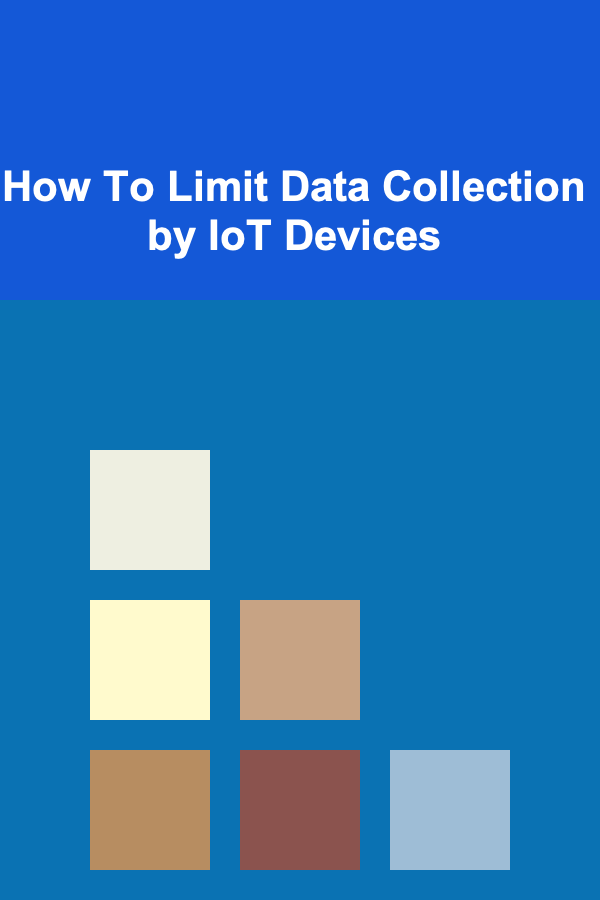
How To Limit Data Collection by IoT Devices
ebook include PDF & Audio bundle (Micro Guide)
$12.99$10.99
Limited Time Offer! Order within the next:

The Internet of Things (IoT) has revolutionized the way we interact with technology, offering convenience, automation, and improved efficiency in various aspects of daily life. From smart homes and wearable devices to industrial applications and healthcare solutions, IoT devices are becoming an integral part of the modern world. However, while these devices bring undeniable benefits, they also raise serious concerns regarding privacy and security, particularly in terms of the vast amounts of data they collect.
Data collection is the backbone of IoT devices. These devices gather data about users, environments, and systems to enhance their functionality and offer personalized experiences. However, this data collection can be excessive, invasive, and often unregulated, creating potential privacy risks for individuals and organizations. Therefore, limiting the data collection by IoT devices is crucial to ensuring privacy and reducing the risk of data breaches or misuse.
This article will explore several strategies and best practices for limiting data collection by IoT devices. By understanding the potential privacy risks and implementing effective measures, users and organizations can enjoy the benefits of IoT technology while maintaining control over their personal data.
Understanding IoT Data Collection and Its Risks
IoT devices rely on sensors, connectivity, and cloud computing to collect and transmit data. This data can range from basic information, such as temperature readings or activity levels, to more sensitive personal information, like health data, location, and behavior patterns. The primary concern with IoT devices is that they are often collecting data continuously, often without the explicit knowledge or consent of the users.
Data Privacy Risks:
- Invasive Data Collection: Many IoT devices collect data beyond what is necessary for their core functionality. For example, a smart speaker may listen to ambient conversations, or a fitness tracker may collect detailed location and health data.
- Lack of Transparency: Users often have limited visibility into what data is being collected, how it is being used, and who has access to it. This lack of transparency creates privacy risks.
- Data Breaches: IoT devices are frequently targeted by cybercriminals because of their connectivity and vulnerabilities. If a device's data storage or transmission is compromised, personal information can be exposed or stolen.
- Data Sharing: Many IoT devices share data with third parties, such as advertisers or data brokers. Users may not always be aware of these third-party data exchanges or the potential for misuse.
Given these risks, it is essential to implement measures that limit unnecessary data collection while still maintaining the functionality of IoT devices.
Steps to Limit Data Collection by IoT Devices
Limiting data collection by IoT devices involves a combination of thoughtful choices during device selection, configuration, and management. The following strategies outline effective ways to reduce the amount of data that IoT devices collect.
2.1. Assess the Data Collection Needs of IoT Devices
Before acquiring an IoT device, it's essential to assess its data collection needs. Many IoT devices come with default settings that may collect data beyond what is necessary for their primary function. For instance, a smart thermostat may collect data on your daily routine, such as when you leave or return home, which may be more than needed for temperature control.
Actionable Steps:
- Review Device Specifications: Research the device's data collection capabilities and understand what data it collects and why. Manufacturers typically provide this information in the device's user manual or privacy policy.
- Identify Unnecessary Data: Determine whether the device is collecting data that is not essential for its function. For instance, a smart refrigerator may not need to track your location or record your voice to provide food storage recommendations.
By critically evaluating the data collection scope, you can make informed decisions about which devices are worth adopting.
2.2. Disable or Limit Non-Essential Features
Most IoT devices offer features that go beyond their basic functionality. For example, a smart camera may include voice recognition, facial recognition, or motion detection features that are not crucial for the device's core purpose of monitoring a home.
Actionable Steps:
- Turn Off Unused Features: Many IoT devices have optional features that collect extra data. Turn off features such as geolocation tracking, data sharing with third parties, and unnecessary sensors when they are not needed.
- Configure Data Collection Settings: Go into the device settings and disable any non-essential data collection. Some devices allow you to adjust the granularity of data being collected, such as limiting the frequency of location updates or disabling certain sensors.
Disabling or limiting non-essential features will help reduce the amount of unnecessary data the device collects while still preserving its core functionality.
2.3. Opt for Devices with Privacy-Focused Features
The growing concerns about privacy have led some manufacturers to offer IoT devices with built-in privacy protections. These devices may offer features that limit data collection or allow for better control over what data is shared and stored.
Actionable Steps:
- Look for Privacy Certifications: Some devices come with privacy certifications, such as those offered by the European Union's General Data Protection Regulation (GDPR) or other privacy standards. These certifications ensure that the device complies with data privacy regulations and provides users with more control over their data.
- Choose Devices with Local Processing: Some IoT devices process data locally, rather than sending it to the cloud for analysis. Devices with edge computing capabilities reduce the need for data transmission and storage, limiting the exposure of personal information.
By choosing devices with stronger privacy protections, you can limit the amount of data that is collected and transmitted to external servers.
2.4. Limit Data Sharing with Third Parties
Many IoT devices share data with third parties, such as advertisers, service providers, or manufacturers. While this can enhance user experience or provide additional services, it also increases the risk of data misuse.
Actionable Steps:
- Opt Out of Data Sharing: Many IoT devices allow you to opt-out of sharing your data with third parties. Look for this option in the device's privacy settings or the associated app.
- Review Privacy Policies: Carefully read the privacy policies associated with each IoT device. Ensure that the company does not share your data with third parties unless necessary and that data-sharing practices are transparent.
- Use Device-Specific Privacy Tools: Some manufacturers offer tools to help manage data sharing preferences, such as setting permissions for how your data is used or shared with third parties.
By limiting data sharing with third parties, you can mitigate the risk of your data being used for commercial purposes or falling into the wrong hands.
2.5. Regularly Update Firmware and Software
Firmware and software updates are essential for maintaining the security and functionality of IoT devices. Many updates fix vulnerabilities that could expose personal data, and they may include privacy-enhancing features or options to limit data collection.
Actionable Steps:
- Enable Automatic Updates: Whenever possible, enable automatic updates for your IoT devices. This ensures that the devices receive the latest security patches and privacy enhancements.
- Check for New Privacy Features: After each update, review the device's settings to see if any new privacy features have been added, such as the ability to limit data collection or adjust security settings.
- Update Device Apps: Don't forget to update the apps associated with your IoT devices, as they may include additional privacy settings and data collection controls.
Regular updates help ensure that your devices are equipped with the latest privacy protections, reducing the likelihood of data breaches or unauthorized data collection.
2.6. Secure IoT Devices and Networks
A critical aspect of limiting data collection by IoT devices is ensuring that they are secure from unauthorized access. IoT devices can be vulnerable to hacking, which may lead to the exposure of sensitive data.
Actionable Steps:
- Use Strong Passwords: Set strong, unique passwords for your IoT devices and the accounts associated with them. Avoid default or easily guessable passwords.
- Enable Encryption: Ensure that your IoT devices use encryption to protect the data being transmitted over the network. This prevents unauthorized parties from intercepting the data.
- Secure Your Network: Protect your home or office network by using a secure Wi-Fi password, and consider setting up a separate network for IoT devices to minimize the potential impact of a security breach.
By securing your devices and networks, you can reduce the risk of data breaches and prevent unauthorized parties from accessing your personal information.
Regulatory and Industry Standards
In addition to personal actions, the IoT industry must also take responsibility for ensuring that devices are designed with privacy in mind. Several regulatory and industry standards are being implemented to protect users from excessive data collection and misuse.
3.1. General Data Protection Regulation (GDPR)
The GDPR, a European Union regulation, is one of the most comprehensive data protection laws in the world. It mandates that companies provide clear, transparent information about data collection practices and give users the right to control their personal data.
3.2. Internet of Things Cybersecurity Improvement Act (IoT Cybersecurity Act)
In the United States, the IoT Cybersecurity Act aims to enhance the security of IoT devices used by federal agencies. The act sets guidelines for manufacturers to follow, ensuring that devices are secure and protect user privacy.
3.3. Privacy by Design
Privacy by Design is a concept that encourages manufacturers to incorporate privacy features into their devices from the outset, rather than as an afterthought. This approach helps ensure that privacy protections are inherent to the design of IoT devices.
Conclusion
Limiting data collection by IoT devices is essential to preserving privacy in an increasingly connected world. By assessing device needs, disabling non-essential features, choosing privacy-focused devices, and securing devices and networks, users can significantly reduce the amount of personal data collected by IoT devices. Additionally, industry regulations and standards are playing a crucial role in ensuring that IoT devices are designed with privacy in mind.
As IoT technology continues to evolve, it is crucial for users and manufacturers to work together to prioritize privacy and data security, ensuring that the benefits of connected devices do not come at the cost of personal freedom and control over one's own data.

How to Make Money Online as an Online Research Assistant: 10 Actionable Ideas
Read More
Why You Should Use a Whiteboard for Daily Reminders
Read More
How to Fund Your Blockchain Startup Successfully
Read More
How To Explore Quantum Finance and Optimization
Read More
Optimize Your Sleep for Better Productivity
Read More
How To Write Remote Work Proposals That Win Clients
Read MoreOther Products

How to Make Money Online as an Online Research Assistant: 10 Actionable Ideas
Read More
Why You Should Use a Whiteboard for Daily Reminders
Read More
How to Fund Your Blockchain Startup Successfully
Read More
How To Explore Quantum Finance and Optimization
Read More
Optimize Your Sleep for Better Productivity
Read More